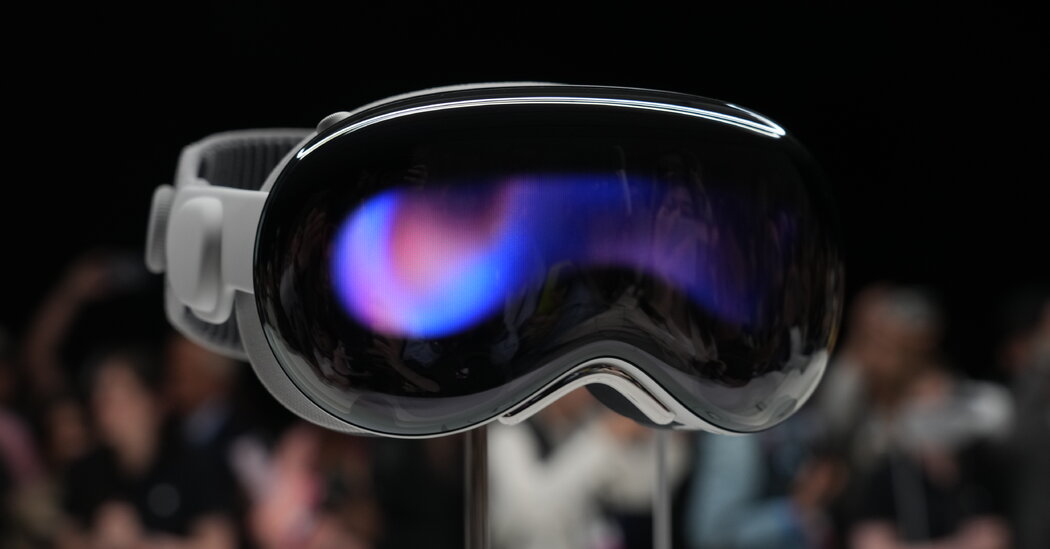Apple lived up to months of expectations on Monday with the introduction of new high-tech glasses that combine the real world with virtual reality. The $3,500 device, called Vision Pro, offers “augmented reality” and introduces “spatial computing,” according to Apple.
But conspicuously absent from the company’s carefully choreographed announcement were the words “virtual reality,” underscoring the challenges the tech giant is likely to face in marketing the device to a mass audience.
Interest in virtual reality picked up shortly after the idea of the metaverse — an immersive online world popularized by science fiction — was introduced to mainstream audiences during the pandemic. But the concept lost momentum as people returned to their prepandemic lives, investors turned to artificial intelligence, and it became clear how much technological innovation would be required to realize such a futuristic vision.
Previous virtual reality offerings, including Google Glass, Magic Leap, Microsoft’s HoloLens, and Meta’s Quest Pro, have been commercial failures or only modest successes. And companies have so far not shown what is indispensable about virtual reality.
Analysts don’t expect the Vision Pro, which will be available early next year, to have great appeal with the general public – at least initially. The $3,500 price could discourage many consumers.
Carolina Milanesi, a consumer technology analyst for the research firm Creative Strategies, said she didn’t think the headset “will be for mass consumers.” Instead, she said, “it will be for early adopters — where Apple most often starts — and developers.”
If the device doesn’t have widespread appeal, it could still be a useful test run for Apple, which could eventually create a virtual reality product aimed at a wider consumer base, such as lightweight glasses.
“I don’t think Apple has super-high expectations,” said Jeff Fieldhack, director of research at Counterpoint Research. “They know this is an evolution that will take some time.”
Apple could also jump to the forefront of the XR market — a term for augmented reality, similar to virtual reality, Mr. Fieldhack.
“I’m sure it will be seen as the best, best in class,” he said. “These will be extraordinary improvements in display quality, resolution, refresh rates, probably the lightness, the feel — all the things that have been the hiccups of XR so far, a lot of them will be addressed.”
The likely challenges the Vision Pro will face in the marketplace couldn’t dampen the enthusiasm of thousands of attendees at Apple’s annual Worldwide Developers Conference Monday. At the company’s spaceship-shaped headquarters in Cupertino, California, they cheered and jeered as Apple executives discussed the device’s features.
In a largely pre-recorded presentation that lasted more than two hours and involved a range of other products, Apple said repeatedly that using the new VR glasses felt like “magic.”
“There are certain products that are changing the way we look at technology and the role it plays in our lives,” said Tim Cook, Apple’s CEO. “We believe Apple Vision Pro is a revolutionary product.”
The headset, which looks like ski goggles, will have a three-dimensional interface where users can view their environment and virtual reality at the same time, or switch between the two to emphasize or block one mode altogether. It will feature the same types of applications, such as FaceTime and Safari, as other Apple devices, with screens that float in the air in front of users’ faces and expand or shrink at will. A wire attached to the headset connects to a battery pack, giving two hours of battery life.
The company said people could unlock the device by scanning their eyes. Customers will use their eyes, voice and fingers to move screens and open apps, without additional hardware. Apple said the Vision Pro would be a useful tool for work and entertainment, with a powerful sound and visual system that resembles a personalized movie theater.
Some have speculated that the Vision Pro could build on Apple’s growing content portfolio and include exclusive content such as movies, games or television shows. In a brief appearance, Disney CEO Robert A. Iger promised nothing but to make Disney+ available on the Vision Pro when it launches.
Apple also announced a range of other updates and new products, such as a 15-inch MacBook Air laptop and improved computer chips for its desktop computers. The company introduced updated operating systems for its computers, AirPods, watches and iPhones, adding features such as a Journal app, FaceTime video messaging and a standby mode with a larger clock on a phone’s home screen.
Largely absent from the event were mentions of artificial intelligence. Apple debuted improvements to its Siri voice command system — such as the ability to recognize pets in clusters of photos — as well as a better autocorrect texting feature and live voicemail transcripts.
But unlike other big tech companies, Apple avoided an in-depth discussion about what AI will mean for the company.

